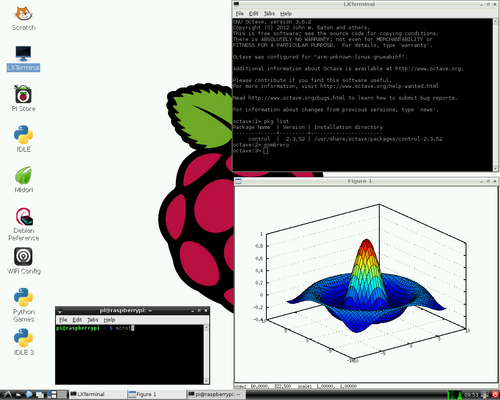Rasperry Pi: Difference between revisions
Jump to navigation
Jump to search
(created octave on Raspbian page) |
(added image from RaspberryPI running octave under LXDE and subchapter how to compile oct files) |
||
| Line 1: | Line 1: | ||
[[File:Raspbian_wheezy_running_octave.png|500px]] | |||
[http://www.raspberrypi.org Raspberry Pi] is a credit-card sized computer that plugs into your TV/Monitor and a keyboard. (see [http://www.raspberrypi.org/faqs FAQ]) | [http://www.raspberrypi.org Raspberry Pi] is a credit-card sized computer that plugs into your TV/Monitor and a keyboard. (see [http://www.raspberrypi.org/faqs FAQ]) | ||
| Line 27: | Line 29: | ||
Just install it with apt-get: | Just install it with apt-get: | ||
$ sudo apt-get install octave-control | $ sudo apt-get install octave-control | ||
== build your own .oct files == | |||
sudo apt-get install liboctave-dev | |||
After that you can compile your programs using "mkoctfile". See [http://www.gnu.org/software/octave/doc/interpreter/Oct_002dFiles.html#Oct_002dFiles GNU octave manual: A.1 Oct-Files] for how to write them. | |||
== Further work == | |||
* Write a simple example which read/writes the GPIO ports from within octave. Perhaps a simple oct wrapper around http://www.open.com.au/mikem/bcm2835/ ? | |||
Revision as of 11:10, 9 January 2013
Raspberry Pi is a credit-card sized computer that plugs into your TV/Monitor and a keyboard. (see FAQ)
octave on Raspbian
The recommended OS is Raspbian “wheezy” and there are ready to use octave packages for that. You can check the available version with "apt-cache policy". As of 9.Jan 2013 this was:
$ apt-cache policy octave
octave:
Installed: (none)
Candidate: 3.6.2-5
Version table:
3.6.2-5 0
500 http://mirrordirector.raspbian.org/raspbian/ wheezy/main armhf Packages
Installing octave is really easy:
$ sudo apt-get update $ sudo apt-get install octave
This will take some time to download (approx. 29MB) and install octave and all of its needed dependencies. After this there is an entry "Programming" - "GNU Octave" in your LXDE menu.
octave-forge packages on Raspbian
If you type
$ apt-cache search octave-
you will see a lot of additional octave forge packages, for example
octave-control - control functions for Octave from Octave-Forge
Just install it with apt-get:
$ sudo apt-get install octave-control
build your own .oct files
sudo apt-get install liboctave-dev
After that you can compile your programs using "mkoctfile". See GNU octave manual: A.1 Oct-Files for how to write them.
Further work
- Write a simple example which read/writes the GPIO ports from within octave. Perhaps a simple oct wrapper around http://www.open.com.au/mikem/bcm2835/ ?
